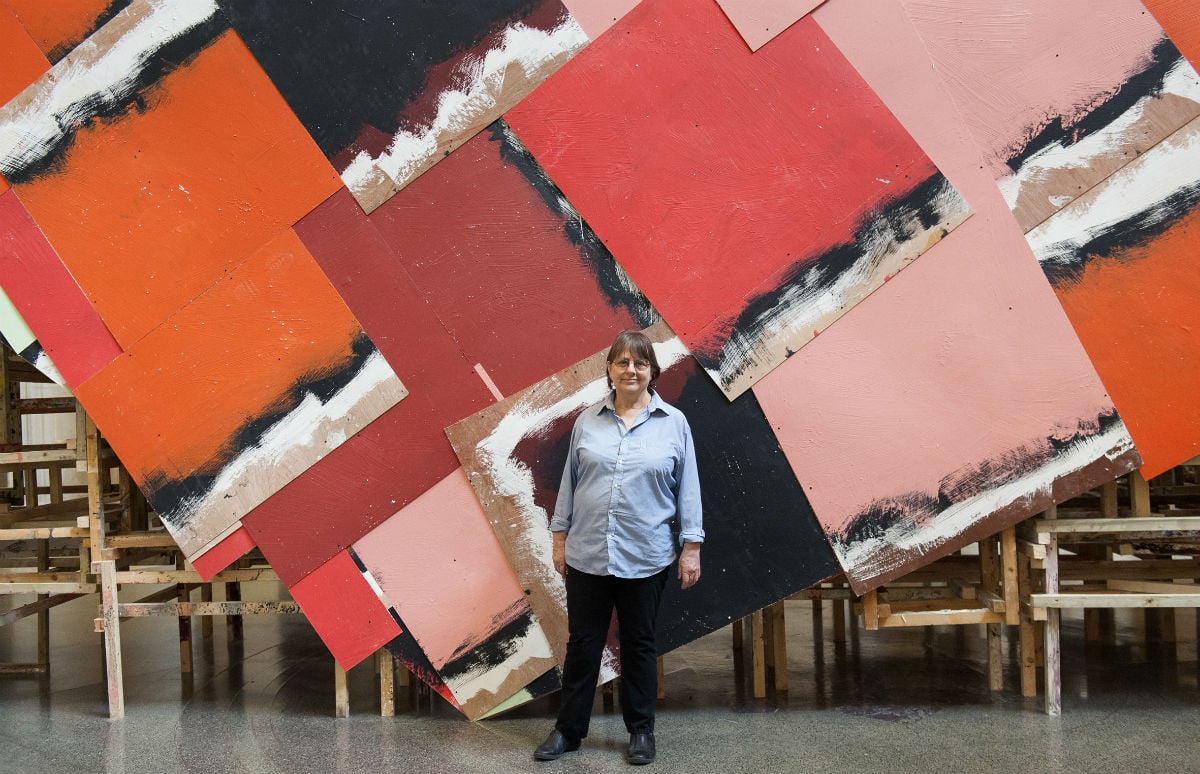
Phyllida Barlow would probably laugh if she heard herself being described as a household name. Yet it is precisely what the sculptor has become, after decades spent in relative obscurity juggling studio work and a teaching career. It was only during the artist’s retirement that the art world started to take full notice of her bold sculptural practice, in which materials such as wood, polystyrene, foam, and tape are turned into ambitious installations grappling with the essence of the sculptural experience. Barlow was elected Royal Academician in 2011, and shown in a slew of prestigious exhibitions including at the Venice Biennale, the Carnegie Museum of Art in Pittsburgh, and the New Museum in New York. Back home, she’s just unveiled her largest piece to date, dock (2014), a series of riotous sculptural assemblages commissioned by Tate Britain for the monumental Duveen Galleries.
What kind of relationship to Tate Britain did you have before you started working on this commission?
A love for it, really. I don’t know when I first came to the Tate, but I distinctly remember so many different sculptures I saw here, from way, way back. I can remember the Epsteins, the Henry Moores—and the Henry Moore exhibition, when the whole of the Duveen Galleries were clad in a kind of white muslin. And then the French sculptors: Laurens, Maillol, Rodin of course, and then the Matisse backs (Back I, II, III, and IV). I can also remember a huge exhibition with Rauschenberg, Larry Rivers, a lot of early pop artists. That opened up the British art world to extraordinary influences from further afield—the traditional sculpture beginning to be rigorously challenged.
Do you think it had an impact on your own formation as an artist?
Very much so, yes.
Phyllida Barlow, dock (2014)
Installation views: Tate Britain 2014
J Fernandes, Tate Photography
So then how did it feel to come back here as the exhibiting artist?
Extraordinary, because I haven’t had a meteoric career in any shape or form, and therefore it wasn’t even on the radar. But what’s interesting about how artists think, is that they do have spaces in their minds that they long for, especially perhaps sculptors. I’ve always felt that the Duveen was incredible, but also awkward, over-reverential and over-authoritarian. It’s definitely going to win over the things that we’re meant to be looking at and experience. So maybe I’ve had a slightly awkward relationship with the Duveen: on one hand absolutely loving it as a space, but questioning something about the intention of its monumentality and its almost church-like, cathedral-like formality and aesthetic. What on earth is that all about? This became an important resource for how I wanted to then use the space.
Has your relationship to the space changed over time?
When I was given the commission in September 2012, the proposal was very quickly put together, and it was very much about questioning how sculpture is shown and experienced. But it hadn’t completely formed itself. Then, of course, the problems all came in thick and fast, and my naivety was fully exposed. But what has happened over the past year and a half is that I’ve inhabited the space mentally every single day, and in some ways, that’s tamed the space to me. Every time I visited, the space looked much smaller—because in my head, it had expanded to beyond vast. Then gradually, those dimensions ceased to be terrifying and became an exciting possibility.
Phyllida Barlow, dock (2014)
Installation views: Tate Britain 2014
J Fernandes, Tate Photography
You mentioned earlier that you had an initial idea that was tweaked and changed. Can you tell me about this process?
The initial idea was to fill the space with about 80 suspended lumpy things, the whole way down. That was going to be managed by scaffolding. Very quickly it became obvious that the sheer cost of that would be phenomenal, and would wipe the budget out. I had a complete meltdown as to how to change the idea, but then an extremely useful conversation with Penelope [Curtis, director of Tate Britain] during which she talked about my earlier work, and the fact that it was very raw, untreated, with things quite spontaneously put together. It was very inspirational. She also talked about editing, which is something I’ve not been good at all. I went away from that meeting with the very clear idea that I didn’t want to say the same thing twice throughout the 100-meter space, that there would be a spatial narrative of contrasts, stoppages, and starting points in the whole journey down the Duveen. About four weeks later, I sat on the steps of the Tate, and in the gloomy, early dusk, I realized that this procession of traffic on the river was relating to the idea of these suspended sculptures. There was this link between the river as a horizontal thing and the Tate running adjacent to it. That became key to developing the work from that point.